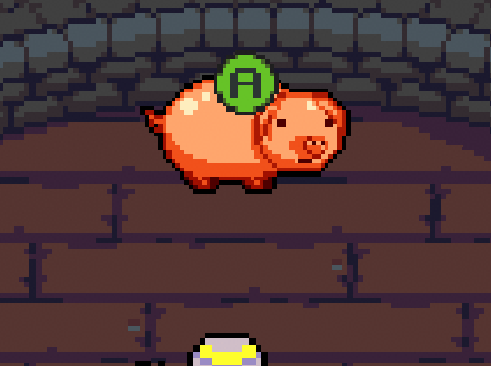Carcastrophe
Comedic take on the legend of Lady Carcas. 2 players must defend a sieged city while feeding a pig who will,
when ready, ultimately push the enemy back.

Context: Game Jam (theme: historical figures from Occitania, France). Game based on the legend of Lady Carcas.
Duties: Game Design, Level Design, UX Design, Programming
Engine: Unity
Team size: 5
Duration: 48 hours
Awards: Jury's prize
Contribution Overview
-
Designed the cooperative aspects of the game and Level Design (more details available below).
-
Programming
-
Implemented various systems and feedbacks based on our intentions and playtests feedbacks throughout development.
Designing Cooperation: interdependance , panic and control
Game overview :

Winning condition : The Pig is filled up.
Losing condition : The trick is exposed (the health bar reaches zero).
To get the experience we wanted, we based the design on three guidelines : interdependance, panic and control.
Interdependance
Conflicting mechanics:
Players can defend the castle by shooting at ennemies and feed the pig by bringing it food. However, performing one means not being able to perorm the other as a player can only hold one item. Defending the Castle is mandatory to stay in the game and feeding the Pig is the only way to victory. So, players are encouraged to keep a global look on the game and collectively plan their actions accordingly.
Conflicting paths:
When both players are defending on the upper level, they can't cross paths. As a result, they must communicate and keep an eye on each other's position to deal with the enemy squads efficiently.
On the Centre Area, the feeding trajectory (from the Haystack to the Pig) is vertical whereas the passage across the area is horizontal. If one player is feeding the Pig the other player defends the Castle on both sides. As a result it is likely their paths will cross in the frenzy. They must be aware of each other even when they don't perform the same action. Each of a player's movement decisions involves the other player.
Unique weapons :
-
The game has 3 enemy types and 3 weapons.
-
Each weapon is dedicated to a specific enemy type.
-
A player can hold only one weapon at a time (pick and drop logic).
Since weapons are unique and frequently dropped around, players don't always have quick access to the weapon they need. The other player might be using it or blocking the way. Then, players both need to assess the situation and pass themselves the weapons or drop them in strategic places to optimise the smoothest defence possible. So, players rely on each other for shooting as well as for moving.
Panic
Increase difficulty overtime :
The more time passes, the more enemy squads are abundant and varied (a squad with different enemy types requires multiple weapons to be neutralised). This way, difficulty increases over the course of the game.
Slow down progression and Increase risk overtime :
-
The Pig has 3 levels to complete to win the game.
-
Players feed it by bringing food and maintaining the "feed" button for a certain time (feeding delay).
-
Feeding the Pig also means not having a weapon in hand.
Each level requires more food than the previous one, the "feeding delay", time during which players are unable to use weapons increases as well. So, the progression is slowed down and requires more careful planning as the game goes on! Mixed with the rising difficulty, it sets up a tension which grows over the course of the game.
Partial information :
The Pig's current level progression is communicated by animation only.

Players know when:
-
They successfully fed the Pig: it stretches, then goes back to normal.
-
They reached a new level: the pig's base size increases (along with a new visual).
But they ignore:
-
How many times they have to feed the Pig to complete each level.
-
How many levels there are.
Players know they are progressing but, as the tension rises and the pig requires more and more attention, they question their distance from the end goal and their ability to hold on until they finally reach it.
Control
Early Information to encourage planning:
Incoming squads' position and type are announced before they appear on the screen. It allows players to plan ahead. They can use this early information to place weapons strategically and can be more confident about feeding the Pig.
Room for error:
The centre area of the Castle is large enough for players to cross each other and is connected to both sides. So, if they have conflicted movements around the Castle, players can use the centre area to get it right fairly quickly. They are constrained and might bump into each other, but stakes are low. Minimising frustration and maximising the collaborative fun of learning to work with each other.
Soft Planning:
While feeding, the "feeding delay" is shown as a gauge. If the action is cancelled before the end of the delay, the gauge slowly decreases. In practice, if a player commits to feeding the Pig and notices an urgent event afterwards, they can drop the feeding and come back to it without too much cost. Players can even relay on the task and fill the gauge cooperatively. This way, players are not punished for paying attention but panic and tension remain.
Easy to learn, hard to master:
Each successful game gets a score based on the damage taken by the castle. Victory is accessible after a few tries. However, will you be able to make one with your mate, optimize the slightest action to improve your score or perhaps achieve the prestigious 100% score?